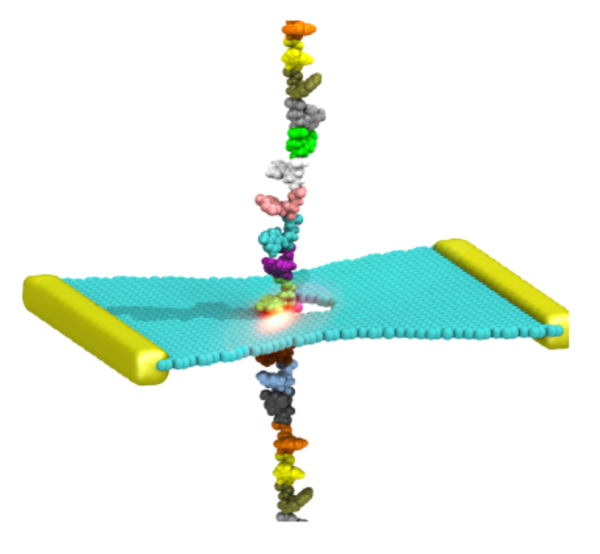C&S6: Nanopore-Based Sensors

Nanosensors utilizing nanoscale holes in solid-state membranes, known as nanopores, are extensively explored as an analytical tool for accurate, fast, and inexpensive human genome sequencing and epigenome mapping. In order to enhance the sensitivity of nanopore-based devices, a variety of approaches have been proposed to control the motion of molecules while they move through nanopores, including the use of multilayered solid-state membranes containing motion-control layers aside from a central sensing layer. Here, Center-developed technologies will enable: (1) design of the multilayered nanopore devices for precise control over molecular motion, and (2) optimization of the nanopore devices for accurate recognition and positioning of DNA nucleotides.
A difficulty in nanopore experiments lies in the high-cost and time-consuming processes of device fabrication, translocation experiments and data analysis, especially when massive tests are required to optimize the design of nanopore devices. Instead of actually building the device, MD simulation can assist and enable a bottom-up design of nanopore devices by unveiling the atomic-level processes occurring during nanopore sensing. A particular problem in the design of solid-state nanopore sensors arises from the lack of atomic-scale understanding of the dynamics of DNA molecules inside nanopores to guide optimization of the sensor for nucleotide recognition. All-atom MD simulations by NAMD (TRD1) can reveal on the atomic-scale how biomolecules behave inside the pore. A further difficulty in computer-assisted design of the sensing layer (e.g. graphene, MoS2) in a multilayered membrane lies in the lack of precise description of electronic interactions between biomolecules and the sensing layer. QM/MM simulations performed with NAMD (TRD1) will enable an accurate description of interactions between DNA and the sensing layer at the quantum level via QM, while describing the transport of molecules through nanopores with the less computationally-intensive classical MM method.
The study of nanosensors will build upon our Center's previous simulation studies, in collaboration with Leburton, on the use of graphene-based nanopore devices as a sensing layer to probe DNA properties by means of transverse electronic current measurement in graphene. The project builds also on the use of a biased solid-state membrane as a motion-control layer to quench DNA fluctuations inside a nanopore . We are currently working on the design of an integrated multilayered device consisting of a sensing layer made of two-dimensional (2D) semiconductors such as graphene or MoS2, as well as multiple motion-control layers made of conducting materials such as gold and copper. Working together with experimental collaborator Bashir, who specializes in design of multilayered nanopores, we proposed the use of a solid-state nanopore to detect protein-labeled methylation sites in DNA. Our recent joint efforts are devoted to the use of 2D materials in methylation detection. We are also working closely with Radenovic, well-known in the area of nanopore DNA sensing with 2D semiconductors, on the design of multilayered nanopore devices for DNA sequencing.
In this project, we will study microscopic kinetics of molecular transport of DNA or methylated DNA-protein complexes through multilayered nanopore devices, with classic MD simulations by NAMD (TRD1). Furthermore, benefiting from the QM/MM approach provided by NAMD (TRD1), we will perform QM/MM simulations of the DNA-nanopore system, in which the sensing layer (e.g. graphene or MoS2) of the multilayered membrane and nucleotides in the pore will be described with the QM approach to ensure accurate evaluation of DNA-nanopore interactions such as π-π stacking, electrostatic and hydrophobic interactions. Once simulation trajectories are obtained, we will determine the electronic current in the sensing layer using the non-equilibrium Green's functions method (Leburton), as applied earlier. The outcome of the study will be tested through the fabrication of devices for applications in DNA sequencing (Radenovic) and mapping of DNA methylation (Bashir).



